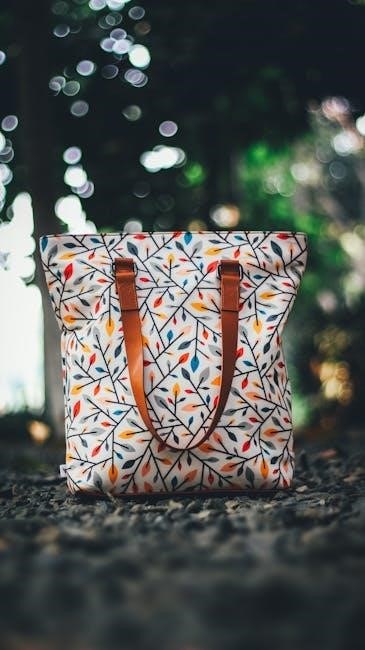tote bag pattern pdf free
- Published
- in PDF
Discover the simplicity of creating eco-friendly tote bags with free PDF patterns. Perfect for beginners, these designs offer customization options, promoting sustainability and personal style effortlessly.
Overview of Tote Bags and Their Popularity
Tote bags have become a versatile and practical accessory, rising in popularity due to their eco-friendly nature and timeless style. Their large, open design makes them ideal for daily use, from grocery shopping to carrying personal items. The shift toward sustainability has further boosted their appeal, as reusable totes replace single-use bags. Crafters and sewists also love them for their simplicity and customization options. With free PDF patterns widely available, creating a tote bag is accessible to everyone, fostering creativity and reducing waste. Their durability and fashionable designs ensure they remain a favorite for both everyday use and special occasions.
Why Choose a Free PDF Pattern?
Opting for a free PDF pattern offers convenience and affordability, making it accessible to crafters of all skill levels. These patterns are often downloadable immediately, allowing you to start your project without delay. Many creators provide detailed instructions, ensuring even beginners can achieve professional results. Free PDF patterns also encourage sustainability by promoting the reuse of materials and reducing waste. Additionally, they foster a sense of community, as sewists share and discover new designs. With a wide variety available, you can find the perfect style to suit your needs, whether it’s a simple tote or a more complex design with added features.
Benefits of Making Your Own Tote Bag
Creating your own tote bag offers numerous benefits, from eco-friendliness to personalization. By using a free PDF pattern, you can craft a bag tailored to your style and needs. It’s a cost-effective way to reduce reliance on single-use bags, promoting sustainability. Customization allows you to choose fabrics, colors, and features like pockets or reinforced straps, ensuring functionality and durability. The process also fosters creativity and skill development, especially for beginners. Plus, handmade bags make thoughtful gifts or unique additions to your wardrobe. With a free pattern, you can experiment without financial risk, making it a rewarding and practical DIY project.

Materials and Tools Needed
Use eco-friendly fabrics like hemp, canvas, or linen for durability. Essential tools include scissors, sewing machines, and measuring tapes. Choose hardware like sturdy straps for functionality and style.
Fabric Requirements and Recommendations
For a durable tote bag, choose medium to heavy-weight fabrics like canvas, linen, or hemp. These materials offer structure and longevity. Consider eco-friendly options to align with sustainable practices. Cotton drill or upholstery fabric also works well for a sturdy finish. Avoid stretchy fabrics unless paired with stabilizers for stability. Pre-wash and dry fabric before cutting to ensure shrinkage is accounted for. Upcycled materials, such as old denim or fabric scraps, can add a unique, eco-conscious touch. Select fabrics that match your desired style, whether modern, bohemian, or minimalist. Proper fabric choice ensures your tote bag is both functional and visually appealing.
Essential Sewing Tools for Tote Bag Making
To create a tote bag, gather basic sewing tools like a sewing machine, sharp fabric scissors, and a rotary cutter with a mat for precise cuts. A ruler or measuring tape ensures accurate measurements, while pins and a seam ripper help with alignment and corrections. An iron and ironing board are crucial for pressing seams and achieving a professional finish. Optional tools include a serger for finishing edges or a walking foot for heavy fabrics. Stabilizers or interfacing can add structure, especially for beginners. Having these tools ready will streamline the sewing process and help you achieve a durable, high-quality tote bag.
Hardware and Notions Needed
Enhance your tote bag’s functionality with essential hardware and notions; Magnetic snaps or Velcro add secure closures, while D-rings or O-rings provide sturdy attachment points for straps. Rivets can reinforce stress points for durability. Thread, in a color matching your fabric, is a must for sewing. Stabilizers or interfacing add structure to the bag’s body or straps. Optional notions include adjustable buckles for customizable straps or reinforced stitching for heavy-duty use. These elements ensure your tote bag is both practical and long-lasting, making it a reliable companion for everyday tasks or special projects.
Step-by-Step Guide to Sewing a Tote Bag
Start by cutting fabric according to your PDF pattern. Sew the body panels together, then attach the straps. Add pockets if desired, and finish the seams for a polished look.
Preparing the Pattern and Fabric
Begin by printing your free PDF pattern and ensuring it is scaled correctly. Choose durable, eco-friendly fabrics like canvas, linen, or hemp for a sturdy tote. Pre-wash and dry the fabric to remove shrinkage. Iron the fabric to eliminate wrinkles for precise cutting. Use the pattern to trace and cut out all pieces accurately. Consider adding stabilizers or interfacing for structure, especially for the bag’s bottom. If desired, cut contrasting fabric for lining or accents. Organize all pieces and hardware before starting to sew. For visual learners, YouTube tutorials like Oklaroots’ two-toned tote guide offer helpful insights. Proper preparation ensures a smooth sewing process.
Cutting Out the Fabric Pieces
Start by printing your free PDF pattern and ensuring all pages are correctly aligned. Use scissors or a rotary cutter to cut out fabric pieces, following the pattern’s markings. Choose durable fabrics like canvas, linen, or hemp for a sturdy tote. If using a two-toned design, cut contrasting fabric for accents. Consider adding stabilizers or interfacing for structure, especially for the bag’s bottom. Use weights or pins to hold the pattern in place while cutting. Ensure accurate cuts by following the grain lines. Double-check all pieces before proceeding. For a professional finish, cut neatly and avoid deviations from the pattern. Organize pieces for easy access during sewing.
Sewing the Bag Body and Straps
Begin by placing the main fabric pieces right sides together and sewing the side seams. Use a 1/2-inch seam allowance for a standard tote. Press seams open for a professional finish. Next, attach the straps by aligning their ends with the top edges of the bag body. Sew in place, ensuring straps are evenly spaced. For durability, reinforce the strap attachments with additional stitching. Optional: Add a French seam or use a serger for a clean finish. Topstitch the edges for a polished look. If using a lining, sew it separately and place it inside the bag before closing the top seam. For a structured bag, consider adding stabilizers or interfacing. Press all seams thoroughly to ensure a crisp finish. Reinforce stress points like strap attachments for long-lasting use.
Adding Pockets and Other Features
Enhance functionality and style by adding pockets and custom features to your tote bag. Sew interior or exterior pockets for organization, ensuring they align with the bag’s seams. Use contrasting fabric for a pop of color or match the bag for a cohesive look. Attach pockets before sewing the bag body together for a seamless integration. Consider adding a reinforced bottom or sturdy straps for durability. For a polished finish, topstitch edges and stress points. Optional features like magnetic snaps or zipper closures can add security. Personalize further with appliques or embroidery for a unique touch, making your tote both practical and stylish.

Finishing the Seams and Edges
Finishing seams and edges is crucial for a professional-looking tote bag. Use a serger or zigzag stitch to prevent fraying on raw edges. For a clean finish, opt for French seams, which enclose the seams completely. Alternatively, bind the edges with bias tape or fabric strips for a decorative touch. Topstitching along the seams adds durability and a polished appearance. Reinforce stress points like strap attachments with additional stitching. For a structured bag, stabilize the bottom with interfacing or a sturdy fabric. Ensure all seams are secure and lay flat for a smooth, professional finish. These steps ensure your tote bag is both durable and visually appealing.

Customization Ideas
Personalize your tote with exterior or interior pockets, appliques, or embroidery. Choose fabrics that reflect your style, from vibrant prints to eco-friendly materials, for a unique look.
Adding Exterior and Interior Pockets
Add functionality to your tote with exterior and interior pockets. Exterior pockets offer easy access for small items like keys or phones, while interior pockets keep valuables secure. Use contrasting fabrics for a stylish touch or match the bag’s material for a cohesive look. Pockets can be zippered or open, depending on your preference. This feature enhances practicality, making the tote versatile for daily use or shopping. Many free PDF patterns include pocket options, allowing you to customize the design to suit your needs. This addition ensures your tote is both functional and fashionable.
Personalizing with Appliques or Embroidery
Elevate your tote bag with unique appliques or embroidery for a personalized touch. Appliques allow you to add intricate designs or patterns using pre-made shapes, while embroidery lets you stitch names, quotes, or motifs. Both methods offer endless creativity, making your bag stand out. Use fabric scraps for appliques or embroidery floss for vibrant details. Many free PDF patterns include space for customization, letting you express your style. Whether it’s a subtle monogram or a bold graphic, these embellishments add character to your tote, turning it into a one-of-a-kind accessory that reflects your personality and creativity.
Choosing the Perfect Fabric for Your Style
Selecting the right fabric is crucial for your tote bag’s durability and aesthetic appeal. Opt for eco-friendly materials like hemp, canvas, or linen for a sustainable choice. Heavier-weight fabrics ensure longevity, while lighter options offer a more casual look. Consider vibrant prints or bold colors to match your personal style, or stick to neutral tones for versatility. Seasonal fabrics, like cotton for summer or wool for winter, can add a unique touch. Ensure the fabric aligns with your intended use—durable materials for everyday bags or decorative fabrics for special occasions. This step allows you to tailor your tote to your lifestyle and preferences perfectly.
Tips for Beginners
Start with a free PDF pattern to practice sewing skills. Choose eco-friendly fabrics like hemp or canvas for durability. Follow tutorials for guidance and customize freely to enhance your learning experience.
Understanding the Pattern Instructions
Start by thoroughly reading the free PDF pattern instructions to ensure clarity. Check fabric requirements, tools needed, and step-by-step guides. Pay attention to measurements, seam allowances, and layout diagrams. Visual learners can benefit from YouTube tutorials for complex steps. Understand key components like bag dimensions, strap lengths, and pocket placements. Familiarize yourself with sewing terms and symbols used. If unsure, take time to research or ask sewing communities for help. Patterns often include tips for customization, so explore options like adding pockets or reinforced straps. Practice patience and don’t rush—each step builds toward a functional, stylish tote. Happy sewing!
Mastering Basic Sewing Techniques
Mastering basic sewing techniques is essential for creating a professional-looking tote bag. Start by practicing straight stitching, backstitching, and sewing in a straight line. Learn to handle fabric properly, ensuring it’s smooth and aligned. Familiarize yourself with seam allowances and how to press seams for a crisp finish. Understanding how to sew straight and curved lines will help you tackle bag bodies and straps with confidence. For beginners, online tutorials and sewing guides can provide visual guidance. Practice on scrap fabric to refine your skills before cutting your final material. Troubleshoot common mistakes like uneven seams or misaligned edges by reviewing your stitches and adjusting as needed. With patience, you’ll build the skills to create a durable, stylish tote bag.
Troubleshooting Common Mistakes
When sewing a tote bag, common mistakes include uneven seams, misaligned edges, or straps that are too long. To fix uneven seams, re-examine your pattern alignment and ensure fabric is smooth before stitching. For misaligned edges, double-check measurements and pin carefully. If straps are too long, shorten them before attaching. Another issue is fabric fraying; use zigzag stitches or sergers to prevent this. Consult video tutorials for visual guidance, as they often highlight these pitfalls. Troubleshooting early ensures a professional finish. Practice on scrap fabric to refine techniques, and don’t hesitate to unpick stitches if needed. Patience and attention to detail will yield a polished result.

Benefits of Using a Tote Bag
Tote bags are eco-friendly, reusable, and versatile, reducing plastic waste while offering practicality for daily use. Their durability and style make them a sustainable and fashionable choice.
Environmental Impact of Reusable Bags
Reusable tote bags significantly reduce plastic waste, minimizing environmental harm. By opting for eco-friendly fabrics like hemp or canvas, you contribute to lowering carbon footprints. Single-use plastic bags often end up in oceans, harming marine life. Tote bags, however, are durable and long-lasting, reducing the need for frequent replacements. Their reusable nature promotes sustainability, encouraging a shift away from disposable options. Making your own tote bag from sustainable materials further enhances its eco-friendly impact. This small change can collectively make a big difference, supporting a healthier planet and promoting responsible consumption. Embrace the simplicity of reusable bags for a greener future.

Practical Uses for Tote Bags

Tote bags are incredibly versatile, serving as eco-friendly shopping companions, stylish work or school bags, and durable travel essentials. Their spacious interiors make them ideal for carrying groceries, books, or personal items. Many users appreciate their functionality for DIY projects, upcycling fabric scraps, or as customizable gifts. Tote bags are also perfect for beach trips, picnics, or daily errands. Their sturdy design and comfortable straps ensure long-lasting use. Whether for practicality or fashion, a well-made tote bag is a reliable and chic accessory for everyday life, offering endless possibilities for organization and personal expression.
Style and Versatility in Everyday Use

Tote bags offer timeless appeal and adaptability, making them a chic addition to any wardrobe. Their spacious design allows for effortless styling, from casual outings to professional settings. With a wide range of fabric options, users can choose materials that reflect their personal taste, whether it’s vibrant prints, neutral tones, or eco-friendly hemp. Functional features like sturdy straps and pockets enhance versatility, while customization options such as appliques or embroidery enable unique expressions of style. Perfect for daily errands, work, or travel, a well-crafted tote bag seamlessly blends practicality with fashion, ensuring it remains a reliable and fashionable accessory for years to come.
Advanced Techniques
Elevate your tote bag with a structured bottom using stabilizers or create reinforced straps for added durability, ensuring a professional finish and long-lasting usability.
Creating a Structured Bottom
A structured bottom enhances your tote bag’s functionality and appearance. Use stabilizers like interfacing or thick fabric to add rigidity. This technique ensures the bag stands upright, making it easier to fill and carry. For a polished look, sew a separate bottom panel and attach it to the bag body. You can also box the corners for a professional finish. This method is especially useful for heavier items, providing durability and shape retention. Follow the pattern instructions or tutorials for precise measurements and stitching. A structured bottom elevates your tote from basic to boutique-quality, offering both practicality and style.
Using Stabilizers for Durability
Stabilizers are essential for adding durability to your tote bag. Interfacing, canvas, or fusible materials can be sewn into the fabric to prevent stretching and enhance structure. These materials are particularly useful for the bag’s bottom and straps, ensuring long-lasting use. By incorporating stabilizers, you create a more professional and robust finish. They also help maintain the bag’s shape, especially when carrying heavy items. Choose the right stabilizer based on your fabric weight and desired stiffness. This step is crucial for a polished, high-quality tote that withstands everyday wear and tear. Stabilizers are a simple yet effective way to elevate your project.
Adding Reinforced Straps
Reinforced straps are a key feature for a durable tote bag; Use sturdy materials like canvas or interfacing to add strength and prevent stretching. Topstitching or sewing multiple layers ensures longevity. For extra comfort, pad the straps with fusible fleece or batting. Reinforced straps not only enhance functionality but also improve the bag’s aesthetic appeal. They are especially important for heavy-duty use, ensuring the bag remains comfortable to carry. By incorporating these reinforcements, you create a tote that is both practical and stylish, capable of withstanding daily wear and tear effortlessly. This detail elevates your project from basic to professional-grade quality.

Resources and Tutorials
Explore free tutorials on YouTube and Ravelry for step-by-step guidance. Downloadable PDF patterns and sewing communities offer inspiration and support for crafting the perfect tote bag.
Recommended YouTube Tutorials
YouTube offers a wealth of free tutorials for sewing tote bags. Channels like Oklaroots provide detailed step-by-step guides, perfect for visual learners. Their tutorials often include tips for customization, such as two-toned designs or adding pockets. Proper Fit Clothing also shares easy-to-follow videos, covering everything from fabric selection to finishing seams; These tutorials are ideal for beginners, breaking down complex steps into manageable tasks. Many creators emphasize using eco-friendly fabrics and reusable materials, aligning with sustainable sewing practices. Whether you’re a novice or looking to refine your skills, these videos offer invaluable guidance to help you create a stylish, functional tote bag.

Online Communities for Sewing Enthusiasts
Joining online sewing communities can enhance your tote bag-making journey. Platforms like Ravelry offer extensive libraries of free patterns, allowing you to filter by difficulty and style. Facebook groups and Reddit forums dedicated to sewing provide valuable support, tips, and inspiration. Many creators share their experiences, from choosing fabrics to troubleshooting common mistakes. These communities are perfect for connecting with fellow sewists, learning new techniques, and showcasing your projects. Resources like The DPL Tote Bag Pattern and Proper Fit Clothing’s tutorials are often highlighted, making it easier to find reliable guides. Engaging with these groups fosters creativity and helps you refine your skills in a collaborative environment.
Additional Free Patterns and Guides
Explore a variety of free tote bag patterns and guides available online. Websites like Ravelry and Digital Pattern Library offer extensive collections, while Proper Fit Clothing provides downloadable PDFs. YouTube channels such as Oklaroots share detailed tutorials, perfect for visual learners. These resources often include customizable options, allowing you to tailor your tote to your style. Many patterns are designed for beginners, with step-by-step instructions to ensure success. Whether you prefer a simple design or a more structured bag, these free resources offer endless possibilities to create the perfect tote. Start your project with confidence using these accessible and user-friendly guides.
Creating a tote bag using a free PDF pattern is a rewarding project that combines creativity with practicality. Start sewing today and enjoy the satisfaction of making something eco-friendly and uniquely yours!
Final Thoughts on Making Your Tote Bag
Creating your own tote bag is a rewarding experience that combines creativity with practicality. Using a free PDF pattern, you can craft a sustainable, eco-friendly accessory that reflects your personal style. Whether you choose vibrant fabrics or neutral tones, the process allows for endless customization. The sense of accomplishment from making something useful is unparalleled. Tote bags are not only environmentally friendly but also versatile for daily use. Encourage yourself to experiment with different materials and designs to make each bag unique. Start your project today and enjoy the pride of carrying a handmade, functional piece that truly belongs to you.
Encouragement to Start Your Project
Embrace the joy of sewing by starting your tote bag project today! With a free PDF pattern, you can easily create a stylish, eco-friendly accessory. Don’t hesitate—gather your materials and begin. Sewing a tote bag is a great way to reduce waste and express your creativity. Whether you’re a beginner or an experienced sewer, this project is both fun and rewarding. Take the first step, and soon you’ll be enjoying your handmade tote. Remember, every stitch brings you closer to a unique, functional piece that reflects your personal style and commitment to sustainability. Happy sewing!
